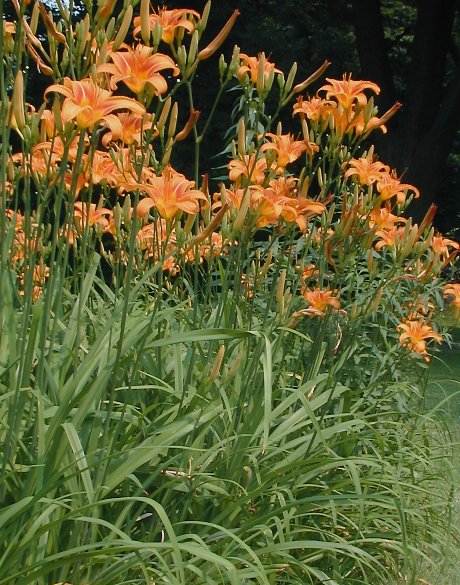Hemerocallis
|
Family: Asphodelaceae |
Herbs, perennial, scapose, clump-forming, rhizomatous, from fibrous or fleshy contractile roots often enlarged at ends; rhizomes spreading. Leaves many, basal, sessile, 2-ranked, bases sheathing; blade long-linear, keeled, apex acuminate. Inflorescences 2, in terminal helicoid cyme, or solitary. Flowers mostly diurnal and ephemeral, slightly irregular, showy; tepals 6, connate basally into short, funnelform to campanulate tube, distinct parts imbricate, spreading, inner broader than outer; stamens 6, adnate to throat of perianth tube; filaments curved upward, distinct, unequal; anthers dorsifixed, 2-locular, linear-oblong, dehiscence introrse; ovary superior, green, 3-locular, conic, septal nectaries present; style curved upwards; stigma indistinctly 3-lobed or capitate. Fruits capsular, leathery, dehiscence loculicidal. Seeds rarely produced (sterile) or many. x = 11. Hemerocallis is important economically as medicinal, poisonous, edible, and/or horticultural plants, which have been in Chinese culture for thousands of years (W. Erhardt 1992). Hemerocallin, a root neurotoxin, can be both poisonous and useful medicinally as an analgesic, diuretic, arsenic-poisoning antidote, and treatment for schistosomiasis (J. A. Duke and E. S. Ayensu 1985; W. Erhardt 1992; Hu S. Y. 1968). In Asia, flowers (buds and perianths), shoots, and tuberous roots (following suitable preparation) are important foods (G. Kunkel 1984). Daylilies are among the most popular North American garden plants. Registered cultivars of Hemerocallis now exceed 38,000, including more than 13,000 named clones of H. fulva (G. Grosvenor 1999; R. M. Kitchingman 1985; R. W. Munson Jr. 1989; W. B. Zomlefer 1998). Hemerocallis has been included in a broadly circumscribed segregate family Hemerocallidaceae with 13-18 genera mainly from the Southern Hemisphere, especially Australia (W. B. Zomlefer 1998; H. T. Clifford et al. 1998), or placed alone in a monotypic Hemerocallidaceae (A. L. Takhtajan 1997). The dwarf, yellow-flowered Hemerocallis minor P. Miller, grass-leaf daylily, has been reported as a local escape in Oregon.
Perianth funnelform, the tep spreading or recurved, connate below into a short tube; stamens inserted at the summit of the tube; filaments elongate, declined; anthers linear, introrse, versatile; ovules numerous; style slender, declined; stigma capitate; tall perennial herbs with numerous long, linear basal lvs and lfless scapes bearing a terminal cluster of large fls, each lasting a single day. 20, temp. Eurasia. Gleason, Henry A. & Cronquist, Arthur J. 1991. Manual of vascular plants of northeastern United States and adjacent Canada. lxxv + 910 pp. ©The New York Botanical Garden. All rights reserved. Used by permission. |

